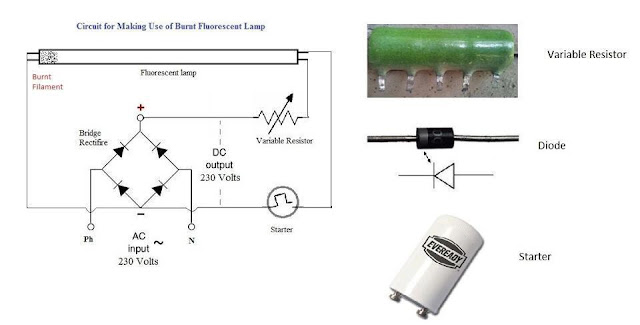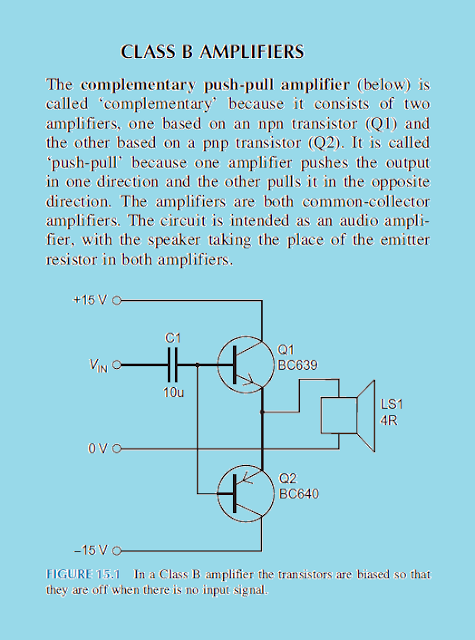
Παρασκευή 7 Ιουνίου 2013
Equivalent Circuit for Ideal Operational Amplifier.....
IDEALIZED CHARACTERISTIC
Open Loop Gain, (Avo) Infinite - The main function of an operational amplifier is to amplify the input signal and the more open loop gain it has the better. Open-loop gain is the gain of the op-amp without positive or negative feedback and for an ideal amplifier the gain will be infinite but typical real values range from about 20,000 to 200,000.
Input impedance, (Zin) Infinite - Input impedance is the ratio of input voltage to input current and is assumed to be infinite to prevent any current flowing from the source supply into the amplifiers input circuitry (Iin =0). Real op-amps have input leakage currents from a few pico-amps to a few milli-amps.
Output impedance, (Zout) Zero - The output impedance of the ideal operational amplifier is assumed to be zero acting as a perfect internal voltage source with no internal resistance so that it can supply as much current as necessary to the load. This internal resistance is effectively in series with the load thereby reducing the output voltage available to the load. Real op-amps have output-impedance in the 100-20Ω range.
Bandwidth, (BW) Infinite - An ideal operational amplifier has an infinite frequency response and can amplify any frequency signal from DC to the highest AC frequencies so it is therefore assumed to have an infinite bandwidth. With real op-amps, the bandwidth is limited by the Gain-Bandwidth product (GB), which is equal to the frequency where the amplifiers gain becomes unity.
Offset Voltage, (Vio) Zero - The amplifiers output will be zero when the voltage difference between the inverting and the non-inverting inputs is zero, the same or when both inputs are grounded. Real op-amps have some amount of output offset voltage.

The buck–boost converter
The buck–boost converter is a type of DC-to-DC converter that has an output voltage magnitude that is either greater than or less than the input voltage magnitude.
Buck-boost converters are mainly used in regulated DC power supplies, where a negative polarity output may be required with respect to the common terminal of the input voltage, and the output voltage can be either higher or lower than the input voltage. The block diagram will help you make the right choice from a wide range of recommended products.
Principle of Operation:
Fig shows The two operating states of a buck–boost converter: When the switch is turned-on, the input voltage source supplies current to the inductor, and the capacitor supplies current to the resistor (output load). When the switch is opened, the inductor supplies current to the load via the diode D.

Construction Of A Relay Switch .....
A relay is an electrically operated switch. Many relays use an electromagnet to operate a switching mechanism mechanically, but other operating principles are also used. Relays are used where it is necessary to control a circuit by a low-power signal (with complete electrical isolation between control and controlled circuits), or where several circuits must be controlled by one signal. The first relays were used in long distance telegraph circuits, repeating the signal coming in from one circuit and re-transmitting it to another. Relays were used extensively in telephone exchanges and early computers to perform logical operations.
A type of relay that can handle the high power required to directly control an electric motor or other loads is called a contactor. Solid-state relays control power circuits with no moving parts, instead using a semiconductor device to perform switching. Relays with calibrated operating characteristics and sometimes multiple operating coils are used to protect electrical circuits from overload or faults; in modern electric power systems these functions are performed by digital instruments still called "protective relays".

Full Wave Rectifier ......
A full-wave rectifier converts the whole of the input waveform to one of constant polarity (positive or negative) at its output. Full-wave rectification converts both polarities of the input waveform to DC (direct current), and yields a higher mean output voltage. Two diodes and a center tapped transformer, or four diodes in a bridge configuration and any AC source (including a transformer without center tap), are needed. Single semiconductor diodes, double diodes with common cathode or common anode, and four-diode bridges, are manufactured as single components.
For single-phase AC, if the transformer is center-tapped, then two diodes back-to-back (cathode-to-cathode or anode-to-anode, depending upon output polarity required) can form a full-wave rectifier. Twice as many turns are required on the transformer secondary to obtain the same output voltage than for a bridge rectifier, but the power rating is unchanged.

8 Common Mistakes While Working on Electronics Workbench....
1. Attaching Batteries.
2. Leaving Wire Joints Open.
3. Misplacing Soldering Iron.
4. Soldering for a Long Time at the Same Place.
5. Reversing Power Supply Polarity.
6. Touching CMOS ICs with a Charged Hand.
7. Removing ICs from the Socket without Using a Lever.
8. Soldering ICs without Using Sockets.

Scalytbot Snake (Snake Robot ) ....
Scalybot, a robot inspired by snakes that climbs inclined surfaces, was built by Georgia Institute of Technology's mechanical engineering graduate Hamid Marvi and his team. The objective of the research was to invent a robot with flexible movements that could be used as assistance systems for future rescue operations. After presenting their prototype to the American Physical Society in Boston, Scalybot 2 has been developed, featuring acceleration sensor to monitor movement and upgrades scales for better grip. Image: The Georgia Institute of Technology

LED or Light-emitting diode ...
A light-emitting diode (LED) is a semiconductor light source. LEDs are used as indicator lamps in many devices and are increasingly used for other lighting. Appearing as practical electronic components in 1962, early LEDs emitted low-intensity red light, but modern versions are available across the visible, ultraviolet, and infrared wavelengths, with very high brightness.
When a light-emitting diode is switched on, electrons are able to recombine with electron holes within the device, releasing energy in the form of photons. This effect is called electroluminescence and the color of the light (corresponding to the energy of the photon) is determined by the energy gap of the semiconductor. An LED is often small in area (less than 1 mm2), and integrated optical components may be used to shape its radiation pattern. LEDs present many advantages over incandescent light sources including lower energy consumption, longer lifetime, improved physical robustness, smaller size, and faster switching. However, LEDs powerful enough for room lighting are relatively expensive and require more precise current and heat management than compact fluorescent lamp sources of comparable output.
Light-emitting diodes are used in applications as diverse as aviation lighting, automotive lighting, advertising, general lighting, and traffic signals. LEDs have allowed new text, video displays, and sensors to be developed, while their high switching rates are also useful in advanced communications technology. Infrared LEDs are also used in the remote control units of many commercial products including televisions, DVD players and other domestic appliances. LEDs are also used in seven-segment display.

Seven-segment display ....
A seven-segment display (SSD), or seven-segment indicator, is a form of electronic display device for displaying decimal numerals that is an alternative to the more complex dot-matrix displays. Seven-segment displays are widely used in digital clocks, electronic meters, and other electronic devices for displaying numerical information.
The seven elements of the display can be lit in different combinations to represent the arabic numerals. Often the seven segments are arranged in an oblique (slanted) arrangement, which aids readability. In most applications, the seven segments are of nearly uniform shape and size (usually elongated hexagons, though trapezoids and rectangles can also be used), though in the case of adding machines, the vertical segments are longer and more oddly shaped at the ends in an effort to further enhance readability.
The numerals 6, 7 and 9 may be represented by two or more different glyphs on seven-segment displays.
The seven segments are arranged as a rectangle of two vertical segments on each side with one horizontal segment on the top, middle, and bottom. Additionally, the seventh segment bisects the rectangle horizontally. There are also fourteen-segment displays and sixteen-segment displays (for full alphanumerics); however, these have mostly been replaced by dot-matrix displays.
The segments of a 7-segment display are referred to by the letters A to G, where the optional DP decimal point (an "eighth segment") is used for the display of non-integer numbers.

Εγγραφή σε:
Σχόλια (Atom)








.jpg)



















